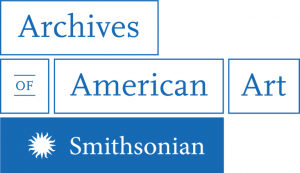Welcome to Conversations across Collections. This entry is the second in a collaborative series between the Archives of American Art and Crystal Bridges where we share the archival backstory on objects from each of our collections. In this blog, Larissa Randall, curatorial assistant, American art, explores preparatory notes and sketches Oscar Bluemner made in advance of his self-portrait. Once you’ve read this story, hop over to the Archives of American Art, and learn more about the history and influences behind Oscar Bluemner’s Self-Portrait and painting diaries.
What may seem like yet another simplified portrait of a flattened figure with bright colors is anything but. Oscar Bluemner (1867-1938) placed great emphasis on the colors he chose, the forms he created, and the mood his paintings conveyed. From October to December of 1933, 66-year-old Bluemner drafted over a dozen pages of preparatory notes and sketches for Self-Portrait, the only self-portrait Bluemner painted during his lifetime.
Crystal Bridges has strong holdings of artist self-portraits; Bluemner’s initially stood out to me because his direct frontal gaze and high-contrast application of cobalt blue and vermillion red exude a masculine, almost devout confidence. The crisp shadows, meticulous line work, and flattened planes of fleshy pale skin convey the same abstract visual language as his expert landscape paintings, such as Crystal Bridges’ stunning painting, Motive of Space and Form-A New Jersey Village (Montville). Bluemner, who trained as an architect in Germany before moving to the United States, painted Motive of Space and Form the year before he relocated from New York to New Jersey. He used sketches from his walks along a Montville canal street to prepare the abstracted landscape and applied his signature vermillion red to distinguish the home in the center of the painting.
Bluemner’s Wordplay
Bluemner immigrated to the United States from Germany in 1892 and quickly made a name for himself as a draftsman and architect. He switched between German, English, and Latin when writing his painting diaries, sometimes combining languages into his own dialect to convey emotions and ideas. The central, red plane that dominates Self-Portrait is inscribed on the top with the mirrored text, “Florianus CMMXXXIII,” which art historian Jeffrey R. Hayes described as, “a Latinization of his [Bluemner’s] own surname that underscores his thirst for wisdom beyond specific time and place.”
It is this playful application of language(s) that fascinates me about Oscar Bluemner. When planning the portrait in his 1933 Painting Diary, Bluemner created an almost paradoxical motto by repeatedly writing variations of the word “simplicity” to describe his tones and line work. I say paradoxical because it is evident from page 24 of his diary that every artistic decision he made was deliberate and thoughtfully coded with personal meaning—anything but simple.
As noted in the left margin of the drawing, Bluemner visualized his future painting with “clear simple force” while writing affirmations in the names of “(Buddha. Caesar. Nietzsche.)” Bluemner maintained interest in German philosopher Frederic Nietzsche throughout his artistic career, which in part explains his self-ostracizing behavior and dramatic perceptions of the audience for his paintings.
Bluemner writes, “Look at my work the way you would listen to music… Look at the space filled with colors and try to feel; do not insist on ‘understanding’ what seems strange… When you ‘FEEL’ color, you will understand the ‘WHY’ of their forms. It is so simple.”
I cannot help but wonder if Bluemner’s coy wordplay parallels the forms he paints, such as the crisp, round form of his skull peering through his translucent, flouncy hair in Self-Portrait, with the heavenly forms mused by philosophers and artists alike. After all, can’t Bluemner’s abstracted, painted shapes and forms exist perfectly and forever as physical objects in beautiful museums? In any case, the playful language in Self-Portrait and Bluemner’s painting diaries reflects his commitment to blurring any distinctions between artmaking and philosophical thinking—a concept that is neither unprecedented nor simple.
Bluemner ultimately stopped painting in 1936 after falling ill and losing his eyesight. He spent his last three years collating and archiving his own artistic and philosophical records, now preserved at the Archives of American Art in Washington DC. He (perhaps retroactively) self-titled all of the writings in his 1933 Painting Diary related to Crystal Bridges’ Self-Portrait, “Own Portrait,” underlined in red-colored pencil, as if making one last declaration of rugged individualism in color before taking his own life in 1938 at age 70.
There’s More to the Story
Want to learn more about Bluemner’s painting diaries? Read the Archives of American Art blog about the history and influences behind Bluemner’s Self-Portrait.
Resources
Haskell, Barbara. Oscar Bluemner: A Passion for Color. New York: Whitney Museum of American Art, 2005.
Hayes, Jeffrey R. Oscar Bluemner: Landscapes of Sorrow and Joy. Washington, D.C. The Corcoran Gallery of Art, 1988.
Hayes, Jeffrey R. Oscar Bluemner. New York, 1991.
This post was written by Larissa Randall, curatorial assistant, American art at Crystal Bridges.
Special thanks to:








